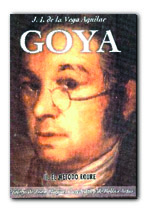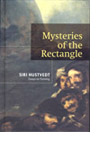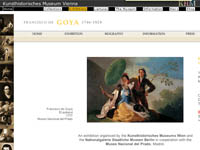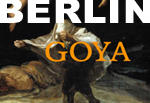
NEWS ARCHIVE 3
|
Looted Nazi artworks being returned, includes Goya work They will be returned to the family of Jacques Goudstikker, a major pre-war art collector who fled the Netherlands shortly before the German invasion in May 1940. A news report on this (and the return of a set of 5 Gustav Klimpt paintings) at leadingthecharge.com brings up an interesting point – there are many still missing works from the Nazi era:
New Book: Hidden Mysteries in Goya's Paintings
Page 22: Second paragraph.- "Almost most of the canvas is imbedded with inscriptions, that must be very interesting given the circumstance, such as those in his paintings. Inscriptions that are just about to be read, but one cannot read them altogether. Goya does not allow them to be read, he rather expects them, one day, to be read. To that purpose he employs the method, instruments, occasion and necessary field; a single hair brush, a pin, for cleaved engraving or relief, or, in a natural manner with a normal brush, only to later paint, stain over it, imbed them taking advantage of those zones in which the inscriptions or legends adapt themselves to the drawing or its forms, and embodying these to configure hidden images. It is so, that in this painting the clothing area has numerous indications of the imbedding.... Much more about this book at goyadiscovery.com
UPDATE: The Forman-Saentz Goya film nears completion
Goya
Movie page
updated
Goya's
Los Proverbios
[Disparates]
online
"Mysteries of the Rectangle" by Siri Hustvedt "Before he fell ill in 1792, Goya gave an address to the Royal Academy of San Fernando about methods of teaching the visual arts. In it he vehemently advocated the importance of working from nature and not from other paintings, sculptures, or casts, which was the common practice in art academies all over Europe at the time. 'I will give a proof to demonstrate with facts that there are no rules in painting, and that the oppression or servile obligation of making all study or follow the same path is a great impediment for the young who profess this very difficult art.' From page 96) The web page for this book at the Princeton Architectural Press is here.
Prado
"...micro-signatures
are
madness
"
Is
there
a
Goya
in
your
home?
Maak:
"Goya
idealised
nothing"
Asmodea
New
Goya
Web
Site
London
Goya
Lecture
by
Dr.
Sarah
Symmons
Dr.
Perales
and
the
World
Art
Service
Foundation
The
Goya
Exhibit
in
Vienna Screenshot of the page site below:
Review
of
the
Vienna
Goya
Exhibit
Siri
Hustvedt
book
covers
Goya's Los
Caprichos "Hellish"
competition
in Vienna
with Goya
exhibit
UPDATE:
Review of
Books has
a collection
of articles
on Robert
Hughes 2003
"Goya"
book Goya
"movie
Page"
updated Berlin
Goya Exhibit
success
Rare Caprichos exhibit in New York City
The New York Sun newspaper has the story here. The New Jersey Star-Ledger covers the exhibit here. 79
Picture
Goya
Exhibit
in
Berlin BBC
"Goya's
Black
Art"
Dr.
Sarah
Symmons
Goya's
"Cannibal
Count"
Found
"From
Goya
to
Sorolla"
Exhibit Graphisms
of
Goya
-
Pavo
Muerto Professor
Antonio
Perales
Martinez Goya
Engraving
Exhibit
in
Moscow What
is
Happening
with
Goya? The
Colossus
(updated) Dead
Turkey
(pavo
muerto) Goya
film
seems
certain |
- - - - - - - - - - - - - - - - -
WEB
SITE COPYRIGHT©1997-2006 ERIK E. WEEMS
IMAGES ARE COPYRIGHT TO THEIR RESPECTIVE OWNERS
http://www.eeweems.com/goya/news_3.html
BIO | ARTWORK | BOOKS | RESOURCES FOR STUDENTS | LINKS | CONTACT | NEWS | NEWS | STATS | F.A.Q.



